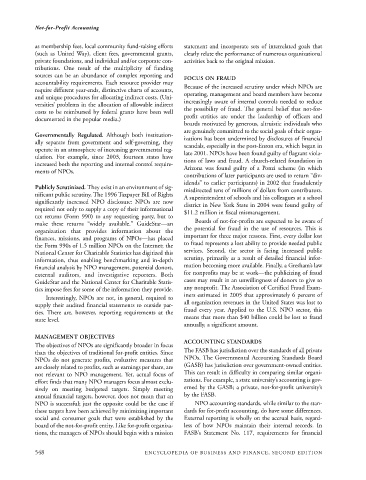Page 571 - Encyclopedia of Business and Finance
P. 571
eobf_N 7/5/06 3:16 PM Page 548
Not-for-Profit Accounting
as membership fees, local community fund-raising efforts statement and incorporate sets of interrelated goals that
(such as United Way), client fees, governmental grants, clearly relate the performance of numerous organizational
private foundations, and individual and/or corporate con- activities back to the original mission.
tributions. One result of the multiplicity of funding
sources can be an abundance of complex reporting and FOCUS ON FRAUD
accountability requirements. Each resource provider may
require different year-ends, distinctive charts of accounts, Because of the increased scrutiny under which NPOs are
and unique procedures for allocating indirect costs. (Uni- operating, management and board members have become
versities’ problems in the allocation of allowable indirect increasingly aware of internal controls needed to reduce
costs to be reimbursed by federal grants have been well the possibility of fraud. The general belief that not-for-
documented in the popular media.) profit entities are under the leadership of officers and
boards motivated by generous, altruistic individuals who
are genuinely committed to the social goals of their organ-
Governmentally Regulated. Although both institution- izations has been undermined by disclosures of financial
ally separate from government and self-governing, they scandals, especially in the post-Enron era, which began in
operate in an atmosphere of increasing governmental reg-
late 2001. NPOs have been found guilty of flagrant viola-
ulation. For example, since 2003, fourteen states have
tions of laws and fraud. A church-related foundation in
increased both the reporting and internal control require-
Arizona was found guilty of a Ponzi scheme (in which
ments of NPOs.
contributions of later participants are used to return “div-
idends” to earlier participants) in 2002 that fraudulently
Publicly Scrutinized. They exist in an environment of sig-
misdirected tens of millions of dollars from contributors.
nificant public scrutiny. The 1996 Taxpayer Bill of Rights
A superintendent of schools and his colleagues at a school
significantly increased NPO disclosure: NPOs are now
district in New York State in 2004 were found guilty of
required not only to supply a copy of their informational $11.2 million in fiscal mismanagement.
tax returns (Form 990) to any requesting party, but to
make these returns “widely available.” GuideStar—an Boards of not-for-profits are expected to be aware of
the potential for fraud in the use of resources. This is
organization that provides information about the
important for three major reasons. First, every dollar lost
finances, missions, and programs of NPOs—has placed
to fraud represents a lost ability to provide needed public
the Form 990s of 1.5 million NPOs on the Internet; the
National Center for Charitable Statistics has digitized this services. Second, the sector is facing increased public
information, thus enabling benchmarking and in-depth scrutiny, primarily as a result of detailed financial infor-
financial analysis by NPO management, potential donors, mation becoming more available. Finally, a Gresham’s law
external auditors, and investigative reporters. Both for nonprofits may be at work—the publicizing of fraud
GuideStar and the National Center for Charitable Statis- cases may result in an unwillingness of donors to give to
tics impose fees for some of the information they provide. any nonprofit. The Association of Certified Fraud Exam-
iners estimated in 2005 that approximately 6 percent of
Interestingly, NPOs are not, in general, required to
supply their audited financial statements to outside par- all organization revenues in the United States was lost to
ties. There are, however, reporting requirements at the fraud every year. Applied to the U.S. NPO sector, this
state level. means that more than $40 billion could be lost to fraud
annually, a significant amount.
MANAGEMENT OBJECTIVES
ACCOUNTING STANDARDS
The objectives of NPOs are significantly broader in focus
than the objectives of traditional for-profit entities. Since The FASB has jurisdiction over the standards of all private
NPOs do not generate profits, evaluative measures that NPOs. The Governmental Accounting Standards Board
(GASB) has jurisdiction over government-owned entities.
are closely related to profits, such as earnings per share, are
not relevant to NPO management. Yet, actual focus of This can result in difficulty in comparing similar organi-
effort finds that many NPO managers focus almost exclu- zations. For example, a state university’s accounting is gov-
sively on meeting budgeted targets. Simply meeting erned by the GASB; a private, not-for-profit university’s
annual financial targets, however, does not mean that an by the FASB.
NPO is successful; just the opposite could be the case if NPO accounting standards, while similar to the stan-
these targets have been achieved by minimizing important dards for for-profit accounting, do have some differences.
social and consumer goals that were established by the External reporting is wholly on the accrual basis, regard-
board of the not-for-profit entity. Like for-profit organiza- less of how NPOs maintain their internal records. In
tions, the managers of NPOs should begin with a mission FASB’s Statement No. 117, requirements for financial
548 ENCYCLOPEDIA OF BUSINESS AND FINANCE, SECOND EDITION

